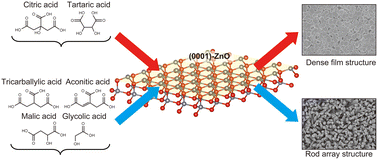Non-seed chemical bath deposition of ZnO films in a rotating continuous flow reactor with various carboxylic acids and their application to transparent conductive films†
Abstract
ZnO films were successfully fabricated by non-seed chemical bath deposition (CBD) using a rotating flow reactor without seed layers. The microstructural control of ZnO films is important for various applications, and dense structures are important for transparent conductive films. Citric acid and citrates are often used to obtain dense ZnO films in aqueous solution because ZnO crystal growth can be controlled by their adsorption on a specific plane. However, how citrates attach to ZnO surfaces and the roles of their carboxylate and hydroxyl groups are still unclear. In this study, various carboxylic acids, such as tricarballylic acid, aconitic acid, malic acid, tartaric acid, and glycolic acid, which have different numbers of carboxylic and hydroxyl groups from that of citric acid, are used to examine their effect on ZnO crystal growth. The effect and roles of the carboxylate and hydroxyl groups on ZnO crystal growth are shown and discussed. Further, the electrical properties and ultraviolet-visible (UV-vis) transmittance of the obtained dense ZnO films are investigated and reported to show the properties of transparent conductors.



 Please wait while we load your content...
Please wait while we load your content...